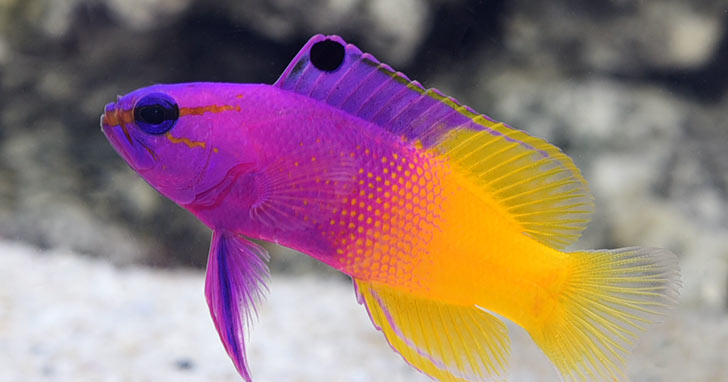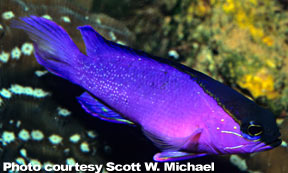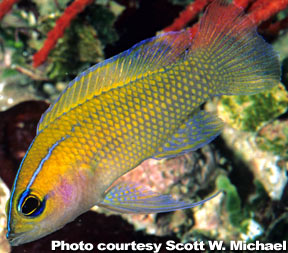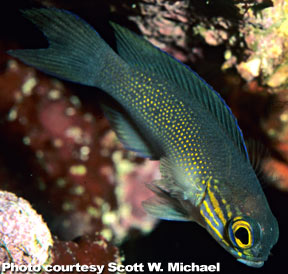Reef Basslets & Grammas - Part 2
By Scott W. Michael
If you are looking for a fish that is not only beautiful, but durable and relatively congenial to its tankmates, then the grammas are for you! These fishes readily adapt to captive life and can be housed in small to large aquariums. They do appreciate lots of good hiding places to retreat into when threatened.
Part II: Grammas (Family Grammatidae: Genus Gramma) The Royal Gramma is ubiquitous in the aquarium trade, and for good reason. It is not only beautiful, it is also durable. Even though they are hardy, they do have some special care requirements. Royal Grammas appreciate lots of good hiding places, in which they can quickly dart into if threatened. They are best kept with passive fishes, rather than overly antagonistic species (e.g., large damselfishes, some hawkfishes, and triggerfishes). If you choose to house them with fish that are potentially aggressive, the gramma should be added to the aquarium before it. If they are the recipients of harsh treatment from tankmates, they will often hide constantly or cower in an upper corner of the aquarium.
The only difference between the sexes is size. On average, males are larger than females and attain a greater length. Therefore, by placing one larger fish and several small fish in an aquarium you are increasing the chances that you will acquire only one male and several females. If you have a smaller aquarium (less than 30 gallons) you should keep only one adult gramma, or possibly a known male-female pair. A vertical reef wall, whether comprised of reef rock or artificial corals, will provide the gramma with a habitat similar to that which they prefer in the wild. If you're keeping more than one gramma, or other planktivores, it will also help to increase inter-individual distances, which will help to curb aggressive encounters. The gramma can also jump out of an open aquarium.
The Royal Gramma is not a threat to most ornamental invertebrates, as a result, it makes a great addition to the reef aquarium. (Some shrimps, like smaller members of the genus Periclimenes spp., are potential prey for a larger gramma.) As far as invertebrates that are a threat to grammas are concerned, the species that poses the greatest threat is the Elephant Ear Anemone (Amplexidiscus fenestrafer). This species feeds by slowly closing up around prey items that rest on its disc. Grammas are just one of a number of fish species that have been observed to fall victim to this large, predatory corallimorpharian. Carpet anemones, large crabs and piscivorous mantis shrimp (most species found in live rock do not fall into this category) are other invertebrates that may be a threat to a gramma. These Royal Grammas are gonochoristic (individuals that do not change sex). Males defend a small cylindrical hole or narrow crevice, often on the side of a coral head or under an overhang, which will serve as a nest. The gramma will use pieces of algae, sea urchin spines and sponge to cover the depression or seal secondary holes that lead to the nest. The male gramma will hover in front of the primary opening or sit in the hole with only its head protruding. If an intruder approaches the hole, the male will defend it by moving toward the intruder with its mouth wide open or contorting its body into an S-shape. The male will also maintain the nest, add pieces of algae that they rip from the substrate or catch as it floats past in the water column, and remove detritus from the hole. Macroalgae and filamentous algae are attached to the wall of the nest and will provide a framework to hold the eggs in the nest. The male gramma will lead the female into the hole and she will lay from 20 to 100 small eggs, about 1 mm in diameter, on the nest material. The eggs have small threads, which enable them to adhere to each. In the aquarium they are reported to hatch in 5 to 7 days, usually after dusk, while in the wild they hatch in 10 to 11 days (the rate of embryonic development is probably temperature dependent). At hatching the larvae range from 2.86 to 3.78 mm in length. The male will guard and tend to the eggs until they hatch and the pair will continue to spawn every day, or every other day, for a month or longer. The fry can be attracted to the surface and a specific portion of the aquarium with a light. They will eat rotifers and newly hatched brine shrimp and grow quickly. Such spawning events are not rare in home aquariums. The other grammas are similar in their care requirement, except for two issues. The other gramma species tend to be more aggressive than G. loreto. As a result, only one should be kept per aquarium unless the tank is large or a known heterosexual pair is required. These other grammas are also likely to pick on their royal cousin. The other difference between G. loreto and the other Gramma spp. is that most others (especially G. melacara and G. linki) are captured in deeper water. As a result, they tend to suffer more from decompression-related maladies. Avoid buying specimens that have a difficult time maintaining their position in the water column and that swim, in a labored fashion, with the tail higher than the midline of the body. These individuals usually spend most of their time wedged in a crevice in order to avoid floating to the surface. Individuals that display these behavioral characteristics are usually suffering from swim bladder malfunction resulting from improper collecting techniques. The grammas are also good jumpers; therefore, it is important to cover the tank to keep them from leaping out. One of the exciting things about these two groups of fishes is that new species occasionally show up in the aquarium trade. As I pointed out earlier, there are species of Liopropoma that are appearing in the trade that I have never seen before in over 35 years of marine fish-keeping! These are exciting times! If you are looking for more details on the species in these three families see my book, Basslets, Dottybacks and Hawkfishes (Microcosm/TFH). Happy fish-watching.
Scott Michael Scott W. Michael is an internationally-recognized writer, underwater photographer, and marine biology researcher specializing in reef fishes, and was the Banquet Speaker at our 2007 and 2008 Coral Conference and Frag Swap. He is a regular contributor to Aquarium Fish Magazine, Freshwater and Marine Aquarium Magazine, SeaScope, and is the author of Reef Fishes Vol 1, Vol 2, Vol 3, Vol 4, and Vol 5, A Pocket Expert Guide Marine Fishes, A Pocket Expert Guide to Reef Aquarium Fishes, 101 Best Saltwater Fishes: How to Choose and Keep Hardy, Brilliant, Fascinating Species That Will Thrive in Your Home Aquarium, Reef Sharks & Rays of the World, and Aquarium Sharks & Rays. Having studied marine biology at the University of Nebraska, Scott has served as a scientific consultant for National Geographic Explorer, the Discovery Channel, and French educational television. |
||||
|
|









